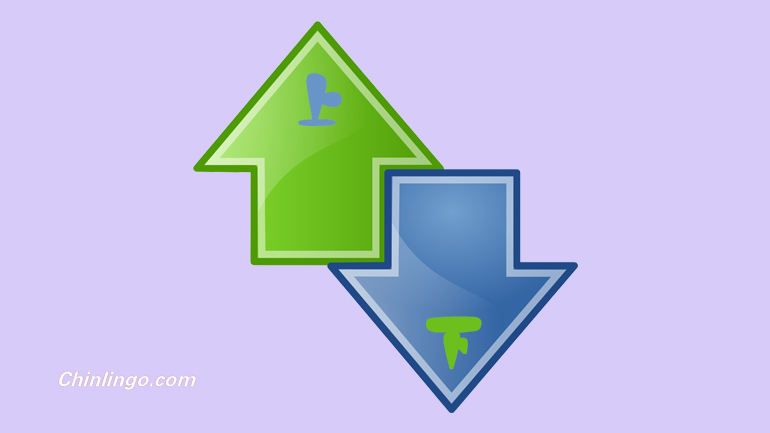
These are two very important, very useful characters when learning Chinese – 上 (shàng) and 下 (xià). In Chinese, you will encounter these two characters very, very often, as they both have many meanings. Let's take a look at some of the many uses of these characters:
“上”和“下”是学中文里非常重要的两个词,你会经常碰到,各有各的含义。我们来看看这两个词的一些用法。
LOCATION – 表方位
To begin with, you can use 上 and 下 to describe the location of something. Here are two examples:
首先,你可以用“上”和“下”表方位。如:
书在桌子上 (shū zài zhuō zi shàng) – This translates to, "The book is on top of the table." In this case, 上 is used to show that something is on top of something else. It can also be used to describe something that is above something else.
书在桌子上 (shū zài zhuō zi shàng) The book is on top of the table.
这里,“上”用来表示某物在另一物的上面或上方。
书在桌子下 (shū zài zhuō zi xià) – More often than not, these two characters serve as opposites, so in this case we have, "The book is under the table." As I'm sure you can guess, 下 is used to show that something is below, or under something.
书在桌子下 (shū zài zhuō zi xià) The book is under the table.
通常,“上”和“下”是反义词,“下”表示某物在另一物的下面或下方。
TIME – 表时间
You can also use the characters 上 and 下 to describe the time (past or future). These characters are used when talking about weeks and months:
你可以用“上”表示过去的时间,用“下”表示将来的时间,通常是星期和月份。
上个星期 (shàng gè xīng qí) means "last week" and 下个星期 (xià gè xīng qí) means "next week." As you may have guessed by now, 上个月 (shàng gè yuè) means "last month" and 下个月 (xià gè yuè) means "next month."
上个星期 (shàng gè xīng qí): last week
下个星期 (xià gè xīng qí): next week
上个月 (shàng gè yuè): last month
下个月 (xià gè yuè): next month
You also see these characters when talking about the time of day:
也可以用于一天中的时间。
早上 (zǎo shàng) – early morning (literally "early on")
上午 (shàng wǔ) – late morning (before noon)
下午 (xià wǔ) – afternoon
晚上 (wǎn shàng) – evening (literally "late on")
RESPONSIBILITIES – 表责任
We all have to either go to class or work at some point in the day, and we can use 上 and 下 to talk about both class and work:
每天的特定时间点,我们要么去上课,要么去上班。可以用“上”和“下”来表示课堂和工作。
上班 (shàng bān) – go to work/begin work
下班 (xià bān) – finish work
上课 (shàng kè) – have class/begin class
下课 (xià kè) – finish class
OTHER USES – 其它
While both 上 and 下 are very common characters in Chinese, you will probably hear and use 下 on a more regular basis.
“上”和“下”在汉语里都很常见,但“下”更常见。
One very common example is, "…. 一下", which means to do something for a short time. Here are a few phrases you might hear or say a lot in Chinese:
一个典型的用法是“……一下”,意思是短时间做某事。比如:
休息一下 (xiū xí yī xià) – rest for a short while
等一下 (děng yī xià) – wait for a short while
看一下 (kàn yī xià) – have a quick look
Basically, you can use the formula (Verb + 一下) to show that you will do something casually, or for a short time.
通常, 你可以用“动词+一下”的结构,表示你随意做某事,或短时间做某事。
Now that you understand a bit more about these two very useful characters, keep an eye (and an ear) out for them when studying Chinese; you will surely find that you see them on a daily basis.
现在你有点明白了吧!在学中文的时候要注意它们的用法,你会发现这两个词在日常生活中很常用。
The article is translated and editted by Chinlingo. Please indicate the source (info.chinlingo.com) for any use, reproduction or transfer.
本文由Chinlingo编译后发布,如需转载,请标明来源:info.chinlingo.com.



 闽公网安备 35020302035673号
闽公网安备 35020302035673号
0 responses on "How to use 上 (shàng) and 下 (xià) in Chinese"